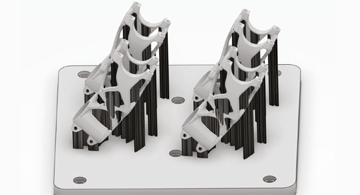5 to Follow – Important Trends in Engineering
Table of contents
The engineering world is an ever changing environment with new developments influencing key decisions and practices. Here are five important trends that your engineering business needs to know about today.
Industry 4.0

Hundreds of years ago, almost all industrialized nations went through its first industrial revolution. It transitioned from hand production methods towards mechanised production processes and has developed through an increasing use of semi-automated, and automated machinery in manufacturing. Today’s industrial revolution, known widely as Industry 4.0 can be described as the move towards a more self-aware and digitised method of work (machinery that fixes itself/robots as your work colleague?).
Industry 4.0 is set to be an important and disruptive trend within engineering in the coming years, utilising the IoT (Internet of Things), big data and the new communication infrastructure. With technology such as augmented reality aiding the engineering development process, smart factories ushering a new era in efficient production, new and exciting opportunities to automate a multitude of tasks whilst re-inventing well established business models, Industry 4.0 looks set to be a trend to dominate engineering for many years to come.
Read more blog posts about Industry 4.0
Additive Manufacturing
Additive Manufacturing (AM) has become a near phenomenon within many industries such as automotive, aerospace, footwear, medical and robotics over the last few years. With the ability to produce 3D objects from materials such as plastic, metal and concrete (or even human tissue one day?), along with the time saving available due to assistance of platform engineering PLM software, it is easy to see why so many industries have become so enthralled with AM.

Is AM as (AM)azing as it sounds? AM may offer manufacturers or consumers the capability to design, create or repair products of their choosing whilst redefining production technology, however will there be any way to regulate which products are manufactured with AM? Can laws police every AM printer to ensure unethical products aren’t manufactured, such as untested medical treatment or unlicensed weapons? Time will tell once AM becomes more prominent in everyday life but what can be seen to be sure now is AM technology is advancing rapidly and is here to stay.
Read more blog posts about Additive Manufacturing
Big Data & Analytics
Big Data reflects the ever growing volumes in today’s world. Significant advancements in technology over the years has seen the internet move from desktops to mobile phones to TV’s, cars and now even wearable tech items such as watches and glasses. Gathering and quantifying everyday data has become even easier. Big data analytics transform data into information then insights which can deliver a number of key benefits to organisations by identifying and automatically pre-qualifying sales leads, increasing the effectiveness of marketing and even helping governments to improve programmes to meet environmental targets within cities. Big data isn’t a slow and time consuming item to gather and analyse either. Just think about the use of today’s internet, near 3.5 billion searches are conducted on Google alone a day. All the data is gathered, stored and analysed instantly as the search is made.

Once again there are ethical questions surrounding big data. Is there a line to which data is seen to be too personal to be stored and analysed? Does the fact that big data can be used by security forces and governments to prevent crimes, cyber-attacks and terror attacks outweigh any unethical challenges?
The technical and ethical issues related to big data are present, however with the ability to make decisions based upon data proving to be a successful formula for many, big data and analytics will be an important and highly coveted trend affecting engineering.
Intelligent Engineering
Is “Intelligent Engineering” more than a modern buzzword within today’s engineering industry such as “IoT”, “Smart” or “Cloud”? Intelligent engineering was implemented near 40 years ago by the clever guys at Dassault Systèmes, when they began to use digital, data driven technology to automate previously manual tasks to deliver innovative engineering processes and practices.

At TECHNIA we also implement and promote the use of “Intelligent Engineering” as we believe in providing customers with products and services with higher operational performance. With the fourth industrial revolution contributing to new technological surges in digitised and automated manufacturing, intelligent engineering will be an important trend within the engineering industry. It must be noted however, individuals are a focal part for any further future success of intelligent engineering. We need to ensure we can develop the human brain along with the science and technology to push for innovation and to change the way organisations operate for greater efficiency and productivity, while cutting costs and time. Our approach to Intelligent Engineering is already improving everyday lifestyles through relationships built between customers and their expectations, organisations and desire for efficiency and competitiveness.
Intelligent engineering will be a vital trend for today’s engineering world and tomorrows as we seek greater productivity through further automation of engineering tasks and processes.
Read more about Intelligent Engineering.
Invisible Governance
When planning or undertaking a project there’s a multitude of requirements and critical deadlines to be met. Unexpected issues, delays and lack of resource produce project risks resulting in project members, who are often dispersed, having to adapt, delay or place their element of the project on hold. As we all know this impacts project delivery and cost.

Typically the declaration of issues and subsequent risk is first highlighted at the project meeting. Seen as a necessary evil, project meetings tend to consist of a series of catch ups, bringing the team and the manager, up to date with progress. Wouldn’t this time be better served by focusing key stakeholders on fixing any issues, and shouldn’t it happen when the risk is first identified?
Having a real-time view of each element of the project as it is being worked on delivers optimal control, removes the need for time hungry meetings and allows project managers to concentrate their skills and time where it really matters thus highlighting the importance of “Invisible Governance”. Invisible governance provides project teams the opportunity to better manage themselves while quickly identifying and addressing potential risks within development projects often before they occur and cause delay or additional cost. Utilising an engineering platform, such as 3DEXPERIENCE from Dassault Systèmes, enables invisible governance from concept design to manufacturing ensuring each member of the project team, whether small or large, is on the same page.
Why is invisible governance a trend in the engineering industry? By being able to identify potential issues before or as they manifest within a project can lead to more efficient projects. It supports minimising delays in addition to simplifying how project risks, tasks and issues are communicated. Invisible governance can increase productivity and improve communication among teams to deliver competitive advantage.
Discover our Engineering Consultancy Services


